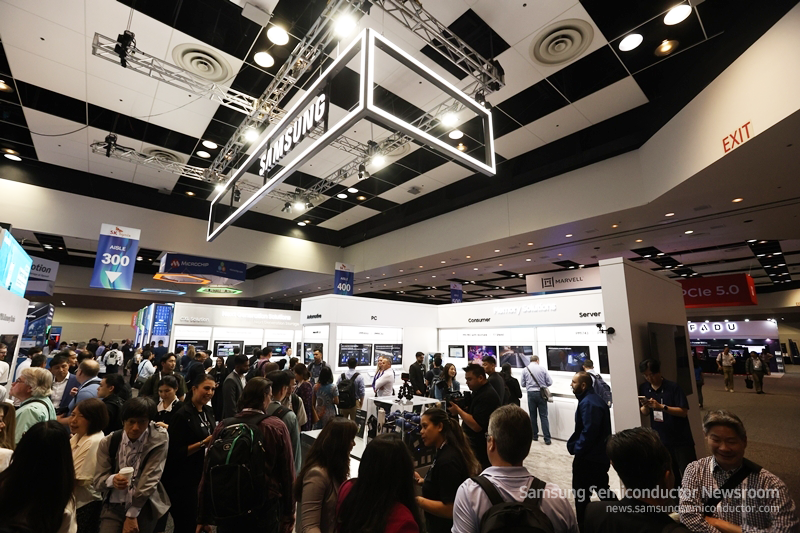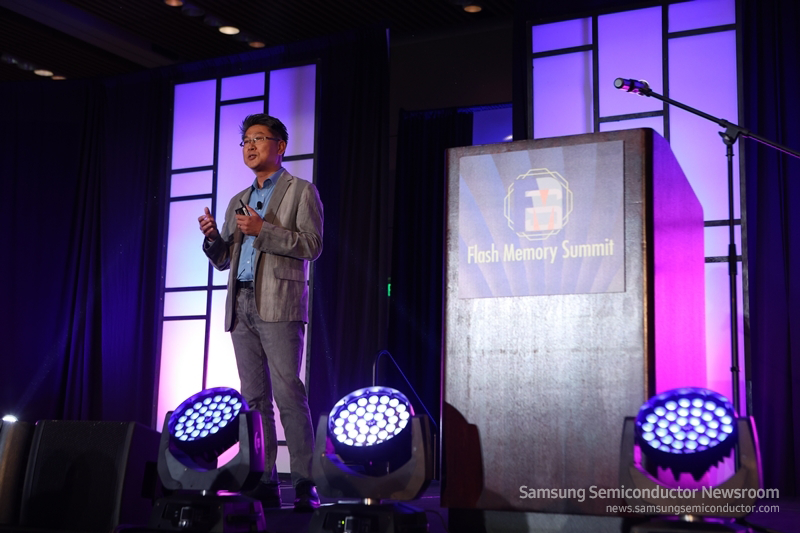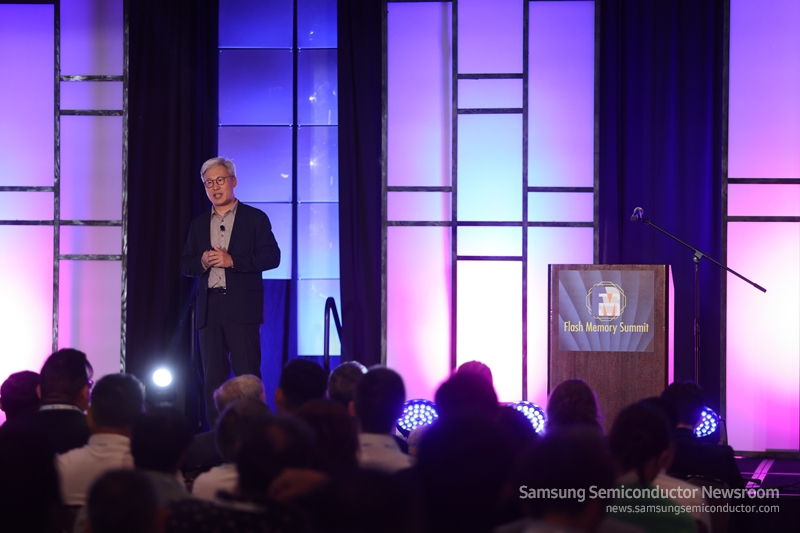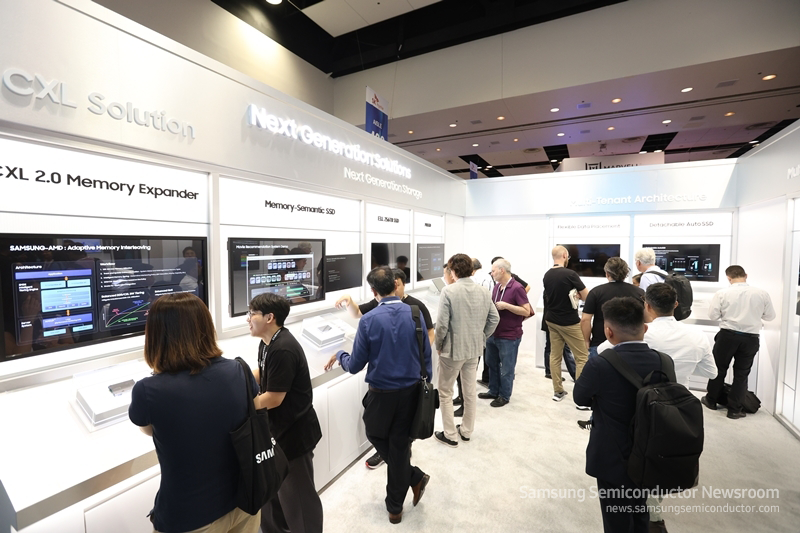Samsung Announces Innovations to Enhance Memory Customer Experience in Data-Centric Era at FMS 2023

Following last year’s successful event, , Samsung Electronics’ semiconductor division returned to Flash Memory Summit (FMS) – the industry’s largest memory conference — to present its vision for the future of memory and showcase its latest solutions..
Jinman Han, President of Device Solutions America, opened the keynote by discussing how Samsung is reimagining memory innovation in the AI era. Yong Ho Song, Corporate EVP of Memory Solution Product & Development at Samsung’s keynote revealed that the tech leader’s vision is to drive customer success as a trusted partner throughout the entire process — from product planning to development, service, and future management. The keynote emphasized that customer success is the company’s highest priority.
With the exponential growth of data and its many applications, the requirements of customer operating servers and datacenters are expanding. The server storage market demands constant power, space, and performance innovation. In addition to developing the latest technology and solutions to meet high-performance demands, achieving maximum capacity within rack power limits poses a challenge. This is due to the physical constraints of datacenters, for which infinite expansion is complex due to space limitations.
In order to stay ahead in the AI era, Samsung must push the boundaries of the server storage market while improving the customer experience. At FMS 2023, the company outlined how it is up to the task. Samsung demonstrated that it is at the forefront of serving customers in full capacity by showcasing an ability to address fast-evolving challenges and demands. Samsung has prioritized customers and at FMS 2023, reasserted its commitment to build a better industry future collaboratively.
In its booth, Samsung highlighted current memory solutions that address customer needs in server, consumer, PC, and automotive markets. And, in next-generation solutions, the innovator highlighted multi-tenant architecture, next-generation storage, and a new CXL memory expander.
.
Keynote Speech and 16 Tech Sessions Centered on Enhancing the Customer Experience

At the three-day event held August 8-10, Song presented “Enhancing Customer Experiences: How Memory Innovations Shape Products and Services.” Samsung Electronics defined the challenges facing the current server storage market as Power, Space, and Performance and introduced key products and technologies to address them.
Song introduced the highly power-efficient PM1743 for use in generative AI servers and the PM9D3a, a PCIe 5.0 SSD with industry-leading performance. Song also announced the latest breakthrough of a 256TB SSD with an unprecedented level of integration density.
Furthermore, Samsung unveiled the PBSSD architecture, a petabyte-scale ultra-high capacity solution that provides scalability through capacity variation depending on the application. The company also revealed its unique multi-tenancy architecture technology that maintains storage performance by implementing Traffic Isolation so that even if multiple users use a single SSD, each virtual machine occupies only its pre-allocated bandwidth and does not interfere with the operations of the others.

The most noteworthy aspect of the keynote speech was the company’s unerring focus on collaborating with customers throughout the production process. To ensure successful customer outcomes, Samsung works with them throughout the whole product lifecycle, from the early planning stage to development, production, operation, and post-sales service.
Before product development is completed, a given product undergoes preliminary evaluation for verification to ensure that it operates smoothly on systems belonging to both Samsung and the customer. After production, Telemetry technology, a remote analysis tool, detects issues that may arise in advance and notifies customers so they can quickly and accurately manage and solve them. Microsoft’s Azure Memory and Storage Center of Excellence uses Samsung’s Telemetry technology. During the keynote speech, Pablo Ziperovich, General Manager of the division, provided a guest talk remotely in which he expressed his satisfaction and expectations for the future of the partnership.
“We will put the highest priority on enhancing customer experiences and continue our efforts to provide optimal memory solutions through omnidirectional collaboration with customers,” said Song.
Sixteen domestic and global speakers presented tech sessions on various topics such as the cloud, AI, open source, and security technologies to showcase Samsung’s storage technology while offering technical exchanges with industry stakeholders.
.
Application-Specific Storage Solutions and Next-Generation Application Technologies for the AI and Data-Centric Era
Here are some more details of the latest storage solutions and technologies that Samsung showcased at FMS 2023:
- PM1743: ‘2x the Power Efficiency of Server SSDs’
The PM1743 server SSD was first unveiled at FMS last year, and it is the first in the industry to apply a PCIe 5.0 interface, achieving twice the power efficiency of its predecessor. Expect to see it in active use this year in the field of generative AI, such as with ChatGPT.
- PM9D3a: ‘PCIe 5.0 SSD for Data Centers Delivering Industry-leading Performance, Power Efficiency, and Increased Reliability’
The PM9D3a supports the PCIe 5.0[1] standard with an 8-channel[2] controller, which improves sequential read performance by up to 2.3 times and random write performance by more than 2x compared to the previous generation PM9A3. This expands the performance per TB capacity, providing 400K input/output operations per second (IOPS) at 8TB. It also delivers industry-leading power efficiency improvements of 60% and significantly enhances Telemetry and Debug functions essential for datacenter maintenance. The PM9D3a achieves a mean time between failure (MTBF) of 2.5Mhr, a 25% improvement over the previous generation, allowing customers to operate more stable services.
Samsung has completed developing the PM9D3a, a high-capacity 7.68/15.36TB 2.5-inch standard product, and plans to introduce a variety of form factors and lineups to meet customer demand in the first half of next year. These include products at 3.84TB and below, ranging up to 30.72TB.
- Quad Level Cell (QLC) NAND SSD: ‘256TB SSD’
A solution for maximum data storage within the power limits of a single-server rack and the limits of physical space, the QLC NAND-based 256TB SSD achieves the industry’s highest level of integration density. Compared to stacking eight 32TB SSDs, one 256TB SSD consumes approximately seven times less power, despite storing the same amount of data.
- ‘Petabyte-Scale’ PBSSD and Traffic Isolation Technology for Multi-User Use on a Single SSD
In addition, the exhibition showcased the latest PBSSD architecture, a petabyte-scale ultra-high capacity solution that provides high scalability by varying the capacity depending on the application. Samsung also provided an in-depth description of its Traffic Isolation technology, eliminating interference in performance and response delays even when multiple users use a single SSD. Through a solution that transcends technological limitations, it is expected to be able to support differentiated services for data center customers, such as flexibly processing the exponential growth of data in the era of Hyperscale AI.
One of the emerging solutions demonstrated together by Samsung and Meta was Flexible Data Placement (FDP). FDP, which has been ratified in NVMe™, optimizes data placement by allowing the host to specify data that is to be grouped together to reduce the write amplification factor (WAF), increase predictability and overall performance, and minimize TCO. The initial results show a clear benefit without major Cachelib optimizations, including a reduced WAF on a hyperscaler real workload, increased SSD utilization while maintaining tolerated WAF, and no impact on cache hit-rate. The software stack used in this demo relied entirely on open-source.
.
In particular, this iteration of FMS was a glimpse of Samsung’s commitment to continuously striving to improve the experience of various customers based on its long-standing product technology know-how, advanced memory technology, and next-generation products.
Samsung sees the data-centric era as an opportunity to embark on a new journey with its customers and partners. Judging by what the company revealed at FMS 2023, it appears fully prepared for that journey.

[1] PCIe 5.0: the latest generation of PCIe, the widely-used, high-speed interface that connects computer components. PCIe 5.0 has a data transfer rate of 32 gigatransfers per second (GT/s), which is twice as fast as PCIe 4.0’s rate of 16 GT/s.
[2] Channel: a unit that allows the SSD controller to process data input and output in parallel to and from NAND flash.
.
